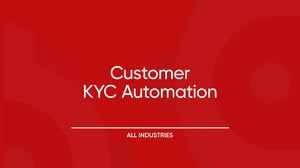
TRADE FINANCE
Automate your trade finance processes like data entry, bill of entry, letter of credit closure, etc. with Intelligent Automation. Automate EXIM processes with intelligent document processing (IDP) and robotic process automation (RPA).
Automation Use Cases for Trade Finance

Auto-verify the documents submitted by the exporter, such as invoices, shipping bills, transport papers, etc. Auto-verify if all documents have been submitted, with the consistency of information, regulatory checks, Anti Money Laundering screening checks, etc.

Auto-update the bill of entry for all export and import cases irrespective of the value, as per the new regulatory guidelines. Manage the one-time updation for historical cases.

Create automatic alerts for all pending transactions on inward remittances on pre-defined days after the transaction date. This is sent to the foreign bank through the SWIFT alliance.

Ratify if all internal payments have been correctly executed in terms of the amount, especially the ones that are due on that day.

Auto-generate the upload file as per the AMLOCK (Anti Money Laundering and Fraud Detection application) application format for Inward LC-related messages for name screening, which helps in determining if any new/existing customer or counterparties are part of any regulatory risks.

Post an auto-extension request for the bill tenor for a further period not exceeding 360 days each (or a rollover request) at the end of each period until the final maturity from issuing bank to the nominated bank. Send the rollover request at least 10 business days prior to the principal bill maturity period. This is the Rollover Inland Lodgment Interest Bill Automation & SFMS (Interest Rollover) process automation.

Generate dumps for discrepant Bank Guarantee (BGs) that are in the parked queue. Auto-filter BGs pending for more than 15 days and 30 days from the report. The Foreign Inward Bank Guarantee (FIBG) 30 Days SWIFT Report process sends a reminder SWIFT to the forwarding bank if the BG is pending for less than 15 days, and a null and void SWIFT, if the BG is pending for 16 to 30 days. This is the FIBG 30 Days SWIFT Report process that automates the processing of SWIFT transactions to the customer.

Auto-reverse the commission fees on bank guarantee as well as bank settlement charges and commissions along with the service tax. This results in reversing the liability into the banking books and also book related profit into different businesses.

Automatically handle the payments due and the closure of the Letter of Credit on the specified date which is 45 days from expiry.

Auto-close the Bank Guarantees which have expired after which 21 days have lapsed from the date of claim expiry. For certain specific guarantees with strict clauses, get standing instructions issued for the collection of monthly commission after expiry.

Ratify if all the payments have been correctly executed in terms of the amount, especially the ones that are due on that day for Letters of Credit.

Auto-recover the commission periodically on bank guarantees issued in favor of government departments even after expiry as per the Domestic Outward Guarantee Auto-Renewal process.

Update all bank guarantee and claims details on a daily basis. Run all the collated data through various macros and formulas to prepare a detailed quarterly Federal Bank Senior Supervisory Manager (SSM) report.

Auto-generate SWIFT messages within 5 days from the date of receipt of documents on release or refusal of payment in compliance with Uniform Customs and Practice for Documentary Credits (UCPDC) provisions.

Auto-execute Import LC payment i.e. TT / PDN as per the LC terms. On T+1 day, check whether for a particular import payment if it has been debited from Nostro account and ensure that there are no errors such as duplicate debits, etc. The MT 940 Checks process helps verify the MT 940 dump against the daily file.

Update the correspondent banks through a SWIFT message with the complete details of the funds being returned on a daily basis.

Auto-extract emails for a customer from the Excel file in pre-configured batch size and update the core banking system.

Auto-process inland bills related to trade for collection/discounting in the core banking system in an end-to-end manner.

Retrieve BG-related data from the system and convert it into a formatted Word file for verifying the authenticity of the BG.

On a daily basis, execute BoE settlement procedures based on statutory guidelines. Capture the required and mandated details and upload these details in the core system. Modify and correct failed cases.

Read data related to outward remittance from the input source and insert into the core banking system.

Retrieve details such as Cost Insurance and Freight (CIF) as well as Unique Identity Number (UIN) related data from input source and update in the core banking site.

Retrieve details from input sources and make an uploadable copy. Run through the checker profile for any discrepancies. Upload to the core system if the parameters are all right, or else route the discrepancy to the concerned stakeholders.

Retrieve the customer data for specific regions from the CRM system at a predefined frequency and take it to the next stage of processing.

Automate the DAG-related processes. Validate the trade data in the financial risk management system and customer relationship management system to check the transaction authenticity and move the data to the next stage of processing.

Auto-create summary based on specific buckets related to daily business deals.

Auto-download data from Export Data Processing and Management System (EDPMS) and send it to the respective customers.

For each CRM service request, auto-open the data files, and extract the data under the required fields in a new Excel file by using Intelligent Automation. Filter the data for the given customer id, paste it into a new Excel file, attach the same file to the service request and close with the remarks “Attached details are for total bills outstanding for this customer code”.

Auto-login the NRI speed remittance, validate and rearrange the text of transactions related to first raising. This is India specific process.

Access the banking application and auto-pick data with respect to all inward SWIFT messages with MT742 (SWIFT message type sent by the paying/negotiating bank to the bank authorized to reimburse the Sender for its payments/negotiations) pertaining to a date range where the “to date” will always be populated as the current date and the ‘from date' shall be input by the user. Auto-populate the different fields according to pre-defined Intelligent Automation logic.

Go to Export Data Processing and Management System (EDPMS), retrieve Bill of Exchange (BoE) service requests, and after processing generate the specified output.

Auto-login to the Director General of Foreign Trade (DGFT) site. Validate the importer-exporter code by downloading different statutory reports and filtering the data with Vlookups.

Download letter of credit data from business applications for MT 700 (a special SWIFT message type used by banks when issuing a letter of credit) and extract proper data in an organized format, that is correspondent-sender, receiver, beneficiary name, etc.

Read and merge data from all international geographies for the entire month from all closed dumps and open dumps to the last date of the month to create a single report.

Filter out the data in the text file as per pre-defined business logic and export it into MS Word document format by using Intelligent Automation. After process completion, generate two output files in the specified path in the current date folder.

Automate the Logical Access Management (LAM) based process. Approve the LAM request for a second approver with Intelligent Automation for a pre-specified threshold of the trade amount.

Automate the Excel sheet-based process for files that are received through email. Auto-create the letter of credit summary based on the email and improve turnaround time.

Auto-retrieve the 595 MIS dump and cross-verify with the core banking application through the Inward Documentary Credit Maintenance and Outward Documentary Credit Maintenance options.

Liberalized Remittance Scheme (LRS) summary reporting is an Excel sheet-based process. Auto-create summary based on keywords required.

Reconcile data between limit tracking system (LTS) and core banking application with Intelligent Automation.

In this core banking application-based process, take inputs from the NRI speed remittance site and upload the massaged file in the core banking system after running through the checker bot. This is India specific process.

Automate the process of retrieving a negative listing of trade entities. Log in to trade finance business applications, such as NRISR, STIR, SMSA, etc., find out transactions that fit in the pre-defined negative listing conditions, and extract the information in an Excel sheet.

This process involves the helpdesk and limit blocking system. Take the service request to self-tray, verify in the trade finance-related systems such as limit tracking system, and then block the limit.

Auto-retrieve UIN and related data from the input source, search in the trade finance-related site and populate names of owners.

Automate the trade finance-related application, such as STIR and core banking application-based process that involves rejection cases. Retrieve data from the systems in an Excel sheet.

Automate the service intermediary verification with the help of MIS 3418 files (Excel dump files) and Intelligent Automation generating the filtered desired data.

Automate Structured Financial Messaging System (SFMS) related processes. Segregate all bank guarantees in Word files and capture the reference numbers in an output Excel file.

Automate the sheet-based processes related to trade finance-related applications such as SMSA. Auto-create a data summary by extracting information as per pre-defined logic.

Automate the transaction assignment by using Intelligent Automation in trade finance-related systems, such as STAR.

Combine the data from multiple input files, which involves extraction of data from different databases, such as Oracle, MS SQL, etc. Filter the files on the basis of predefined customer classification parameters to create different Excel file reports, and upload them to CRM.

Perform data massaging and combine data from different input files, which involves extraction of data from MIS systems. Subsequently, calculate “Renewal Pending Since (Days)” in “Final Output File”, and upload in CRM system.

Take multiple LTS MIS files as input files, use Intelligent Automation to Vlookup the required data, and export into the Excel output file.

Block the limits for different countries by using Intelligent Automation with the LTS system. Sometimes users do the wrong entries. Discard those wrongly done entries with Intelligent Automation, which goes to the LTS system and searches the tracking number, and discards entries.

Select input in PDF / HTML format. Perform different operations like converting PDF to Excel; converting PDF to Excel based on master keyword input files and output files containing only keyword records, and converting PDF to Excel based on master keyword input files and the output files not containing any keyword records. This is India specific process.

Create reports from the core banking system, international private banking system (IPBS), and related SWIFT transactions by using Intelligent Automation. Auto-generate a plethora of diagnostic reports and revenue reports based on pre-defined business rules and conditions to curb money laundering. Auto-reconcile data and generate the final report.

Automate trade finance processes using Intelligent Automation spanning direct debit cancellation, account closures, clearing house automated payments (CHAPS), foreign payments, audits reports, internet applications, card and PIN Pulls.
Make phenomenal savings in terms of time with audit being conducted in a single minute as compared with 6-7 hours manually.

Ingest data from promissory notes and transfer the data to the core banking system using Intelligent Automation.

Auto-download thousands of documents from multiple source systems to a standardized shared drive and auto-extract the required information. With the help of Intelligent Automation, use fewer access rights and reduce the risk of business data being lost, compromised, or accessed by unauthorized users.

Intelligent Automation is a direct function of People-Process-Technology integration.
Download Now →
Download Now
Datamatics deployed Intelligent Document Processing (IDP) solution, TruCap+ powered by Artificial Intelligence and Natural Language Processing (NLP)
Download Now →
Download Now
Check how the Customer KYC Automation process is automated with the Datamatics Intelligent Automation platform.
Watch Now →
Bankers' Guide To Robotic Process Automation
What you get:
- A list of 100+ RPA banking use cases & examples that can be automated with Robotic Process Automation
- RPA use cases & examples across Retail Banking, Corporate Banking, Direct Banking and Trade Finance
Talk To An Automation Expert
Talk to a automation expert from Datamatics about your specific challenges or queriesand we will walk you through solutions that can help



